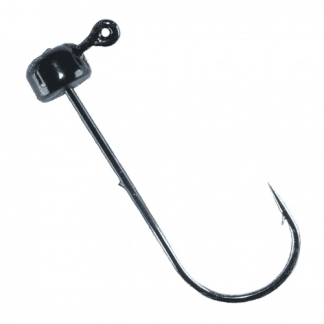
By Chad Hill
Kitana Hooks Pro Staff
Castaic Pro Staff share their inside tips, tricks, and advice.
Like most others, bass fishing is a trendy sport that is often dominated by the latest-and-greatest “hot, new thing”. Boats, motors, rods, reels, and tackle are all subject to this churn. Terminal tackle, hooks for example, are no different. In recent years, hooks have trended more toward wide gap and extra-wide gap as well as heavy wire and extra-heavy wire models. Recently, a variety straight-shanked hooks, for flippin’ and pitchin’, have taken some of the headlines. While each of those have their place in an angler’s arsenal, some sage advice is to look past the trends and headlines and spend some time with a dependable hook design that has been around for decades and will be around as long as there are bass to catch. What hook design do I speak of? It is the round-bend or j-bend hook.
The round bend hook is much like that favorite old fishing lure you have. You know, the one you tie on whenever ever you “need” a bite. The round bend hook design is THAT dependable. It can be found in a variety of sizes in both light and medium-sized wire models. Kitana’s round bend hook is no exception. In fact, it is exceptional! It can be purchased in sizes from 2/0 to 6/0 in a medium wire that is as versatile as a Swiss Army Knife.
Let’s examine the what, where, when, and why of three fantastic ways to employ a Kitana round bend hook.

Presentation 1 – The Carolina Rig:
With one-half of the “what” just being revealed, let’s add some soft plastics to the business end of the sometimes overlooked and often underestimated “ball and chain”. Lizards six to eight inches in length, four to six-inch creature baits, and seven to ten-inch straight-tail worms are go-to choices and will perform well in most situations when paired with a round bend hook whose size is matched to the bait being presented. No matter the profile of soft plastic presentation, color choice should be dictated by the sky and water conditions, dominant bass forage, and angler confidence. Sometimes, color choice matters more to the angler than the bass, but that is a conversation for another day.
Work a Carolina rig on primary and secondary points as well as staging areas in pre-spawn situations. Lizards are a great choice at this time of year. In the post-spawn, drag a creature bait across the same points that were targeted during the pre-spawn following the fish as they migrate away from their spawning grounds along the same route used on their way in. As post-spawn turns to summer, work a Carolina rigged straight-tail worm on the ends of dominate main lake points, ledges, and steep contour changes.
During this time, bass are bombarded by crankbaits, magnum spoons, and large Texas rigs. Dragging a subtly presented finesse worm gently past them impaled on a 3/0 round bend hook is sometimes just what the “fish doctor ordered” to fire up a group of bass. Allow the time of year, water color, water temperature, and fish’s mood to dictate retrieve speed. Vary the drag rate until the bass respond positively. The weight choice should be just enough to provide a good feel of the bottom contour without dredging.
A light to medium wire round bend hook is an excellent complement to a Carolina rig for three reasons. First, light and medium-wired hooks more easily penetrate a bass’ mouth on a sweeping-type of hookset employed with this presentation. Lighter wire hooks also allow for soft plastics to hover off of the bottom. If a floating-type soft plastic is used, it will float a bit higher with this type of hook. Finally, a round bend hook allows slimmer, more finesse-like soft plastics to be presented in a very realistic manner, which helps tempt today’s more education bass into biting.

Presentation 2 – Floatin’ Worm:
The “what” part of this presentation is self-explanatory for the most part. Strait-tailed, finesse-type worms from six to eight inches in length are the most effective choice under most circumstances. There are two avenues for color choices: bright/shock colors such as methiolate and lime, or natural hues such as watermelon and smoke.
Apply a floatin’ worm in clear to moderately stained water situations from immediate pre-spawn through the post-spawn with a twitch and pause retrieve. When rigged correctly, a floatin’ worm can be retrieved in a “walk the dog” style just a few inches beneath the surface. The bass will tell the angler the preferred cadence if allowed to do so. And, remember to bring the floatin’ worm back out in the fall as most bass move to the shallows to feed in preparation for Old Man Winter’s arrival. It is a presentation the bass do not see much that time of year.
Like with the Carolina rig, a round bend hook offers three distinct advantage to the floatin’ worm presentation. The depth and sink rate can be dictated and controlled based on the size and wire-type of hook selected. Also, the bait’s action can be adjusted based on how far from the head of the worm the hook is positioned. Finally, floatin’ worm presentations often involve light line, eight to twelve-pound test, in most situations. Compared to other hook styles and wire gauges, light and medium wire round bend hooks more easily penetrate a fish’s mouth when using lighter line.
Presentation 3 – Texas Rig:
The primary soft plastics choices for this Texas rig discussion are four to five-inch creature baits and six to ten-inch straight-tail worms. Much like the previous presentations, color choice should be dictated by dominant bass forage along with sky and water conditions. However, natural or lighter colors like green pumpkin, watermelon, and plum get the nod with this presentation much of the time.
Cast this finesse-type of Texas rig to main lake and secondary points, vertical banks, channel swings, deep grass edges, and ledges from early summer until mid-fall. Match this presentation with as light of slip sinker as can be gotten away with using ten to fourteen-pound test line. Choose the size of round bend hook that matches the profile of the chosen bait. This finesse-approach to a Texas rig is effective on pressured summer bass that have seen everything anglers can “throw at them”. It can be fished with much success behind other anglers.
The advantages of employing a round bend hook with this presentation are very similar to those of the previous presentations discussed. The goal here is to offer the bass a subtle, harmless looking meal opportunity immediately in front of their faces. The round bend hook matches perfectly with slimmer, small profile presentations to provide this effect. The round bend hook will not overpower the bait preventing the subtle, life-like presentation desired. And, this hook easily penetrates a fish’s mouth when set on lighter lines.
The round bend, or j-bend, hook is a workhorse throughout the year as it is a vital component on a Carolina rig, a floatin’ worm and a finesse Texas rig, which provide an angler with bass-catching presentations from early pre-spawn through mid-fall. Round bend hooks are matched to presentations that are often overlooked in today’s bass fishing as anglers scramble to stay up with the latest lures and techniques. An angler won’t “break the bank” when adding some round bend Kitana hooks in a variety of sizes to his or her arsenal of terminal tackle, but he or she might just steal the headlines with a winning tournament catch or the bass of a lifetime.





